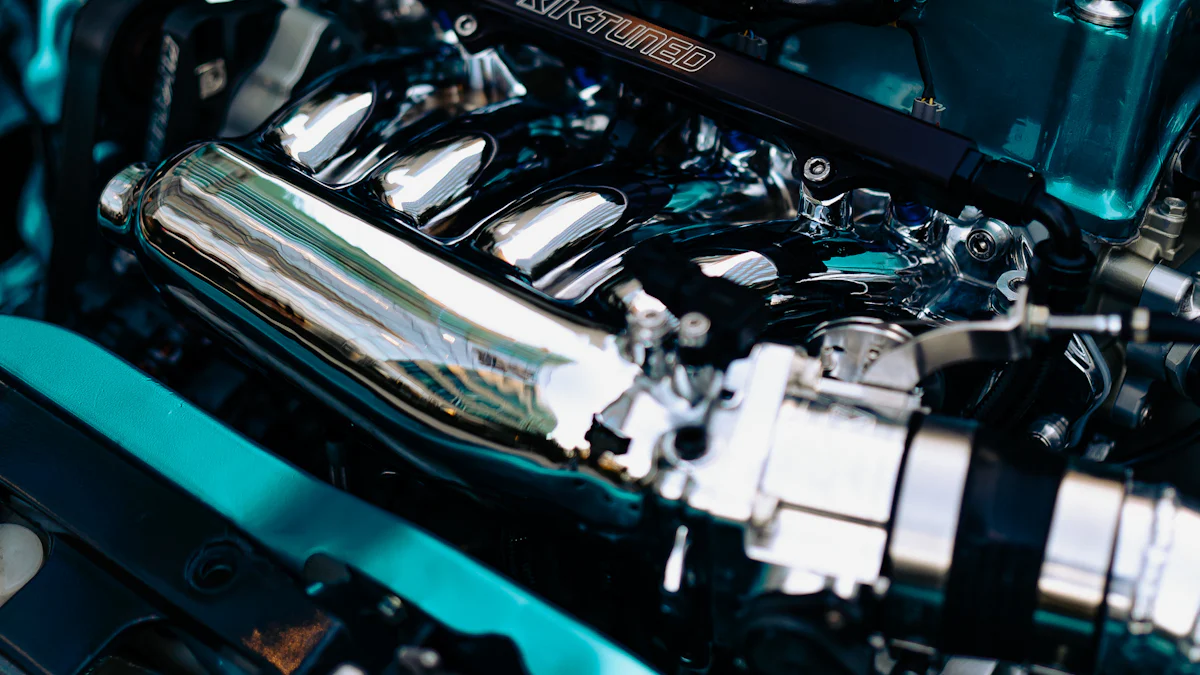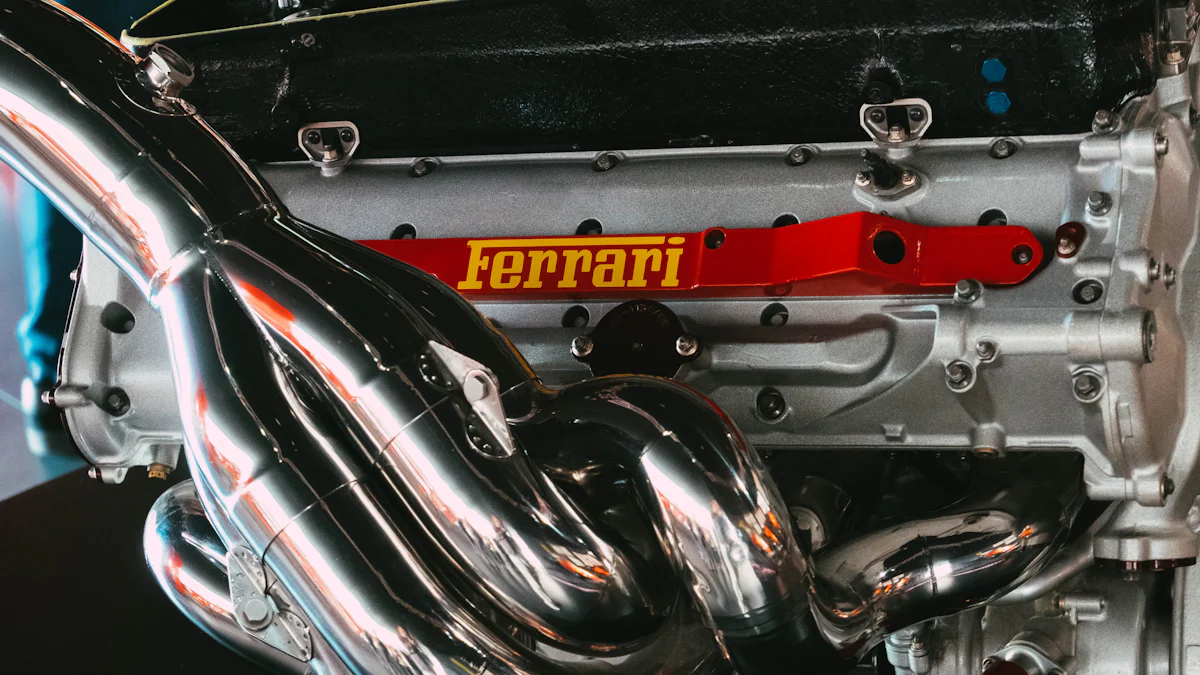
Emphasizing the significance of proper torque specifications is paramount in ensuring the optimal performance of an Engine Exhaust Manifold. Understanding the nuances of the 6.0 LS engine is crucial for enthusiasts and mechanics alike to appreciate its power and capabilities fully. By adhering to the precise 6.0 LS Exhaust Manifold Bolt Torque Specs, one can unlock a myriad of benefits, including enhanced engine longevity and improved overall efficiency.
Understanding Exhaust Manifolds

When it comes to Engine exhaust manifolds, these components play a vital role in the efficient operation of an engine. The Dorman Exhaust Manifold Bolt is crucial for securing the manifold in place and preventing any leaks that could affect performance.
What is an Exhaust Manifold?
The engine exhaust manifold serves as the gateway for exhaust gases to exit the engine cylinders. Its primary function is to collect these gases from multiple cylinders and channel them towards the exhaust pipe for emission. This process ensures that the engine runs smoothly without any backflow disruptions.
Function and Importance
The significance of an exhaust manifold lies in its ability to streamline the exhaust gases’ flow, preventing any interference between cylinders. By efficiently guiding these gases out of the engine, it enhances overall performance and fuel efficiency.
Types of Exhaust Manifolds
There are various types of exhaust manifolds available, each catering to specific engine requirements. From cast iron options known for their durability and cost-effectiveness to stainless steel variants offering corrosion resistance, choosing the right material can significantly impact your vehicle’s performance.
Durable Exhaust Manifold
Investing in a durable exhaust manifold can bring about a host of benefits for your vehicle. Whether it’s the robust construction that withstands high temperatures or the longevity that ensures prolonged use, opting for quality materials can enhance your engine’s efficiency.
Features of a Durable Exhaust Manifold
- Heat Resistance: Withstand high temperatures without compromising performance.
- Corrosion Resistance: Protect against rust and deterioration over time.
- Longevity: Ensure prolonged use and reliability for your vehicle.
Benefits of Using Durable Exhaust Manifolds
- Enhanced Performance: Improve engine efficiency and power output.
- Long-Term Reliability: Minimize maintenance needs with durable components.
- Cost-Efficiency: Avoid frequent replacements by investing in quality parts.
Exhaust Manifold Bolts
While often overlooked, Exhaust Manifold Bolts are essential components that secure the manifold in place. Choosing the right type of bolt ensures proper installation and prevents potential leaks that could impact your engine’s performance.
Role of Exhaust Manifold Bolts
- Securely fasten the exhaust manifold to prevent leaks.
- Maintain proper alignment between the manifold and cylinder heads.
Types of Exhaust Manifold Bolts
- Standard Steel Bolts: Common choice for general applications.
- High-Strength Alloy Bolts: Ideal for heavy-duty or high-performance engines.
Exhaust Manifold Hardware Kit
When it comes to Exhaust Manifold Hardware Kits, they encompass a range of components essential for securing the exhaust manifold in place. These kits typically include bolts, nuts, washers, and other necessary hardware to ensure a secure and reliable connection between the manifold and the engine.
Components of an Exhaust Manifold Hardware Kit
- Bolts: Securely fasten the exhaust manifold to prevent leaks.
- Nuts: Provide additional support and stability to the assembly.
- Washers: Distribute pressure evenly across the connection points.
- Gaskets: Seal any gaps or irregularities between the manifold and engine surface.
These components work together seamlessly to create a robust and durable connection that can withstand high temperatures and vibrations, ensuring optimal performance of the exhaust system.
Importance of Using High-Quality Exhaust Manifold Hardware
Investing in high-quality Exhaust Manifold Hardware is crucial for several reasons. Firstly, superior hardware ensures a tight and secure fit, preventing any potential leaks that could compromise engine performance. Secondly, durable hardware can withstand extreme conditions, including heat cycles and vibrations, without loosening over time.
By opting for top-notch hardware from reputable manufacturers like Werkwell, you guarantee precision engineering and reliability in every component. The use of quality materials not only enhances the longevity of your exhaust system but also contributes to overall vehicle efficiency.
6.0 LS Exhaust Manifold Bolt Torque Specs
Specific Torque Specs for 6.0 LS
First Pass Torque Specs
When securing the 6.0 LS exhaust manifold bolts during the initial pass, it is crucial to apply a torque of 15 Nm (11 lb-ft). This precise specification ensures that the bolts are adequately tightened without risking damage to the components.
Final Pass Torque Specs
For the final pass of torquing the exhaust manifold bolts, it is recommended to apply a torque of 25 Nm (18 lb-ft). This definitive step guarantees that the bolts are securely fastened, contributing to optimal engine performance and longevity.
Chevrolet Silverado Police Pursuit
Torque Specs for Chevrolet Silverado Police Pursuit
In the context of Chevrolet Silverado Police Pursuit vehicles, adhering to specific torque specifications is paramount for maintaining operational efficiency and safety. The recommended torque for exhaust manifold bolts in these vehicles aligns with industry standards to ensure reliable performance under demanding conditions.
Importance of Proper Torque in Police Vehicles
The significance of following proper torque specifications in Chevrolet Silverado Police Pursuit vehicles cannot be overstated. By meticulously torquing each bolt according to manufacturer guidelines, law enforcement agencies can uphold vehicle reliability, operational readiness, and officer safety during critical missions.
Super Cruise Deep Dive
Impact of Torque Specs on Super Cruise
When delving into the intricacies of Super Cruise technology, understanding the impact of precise torque specifications becomes evident. The correct torquing of components, including exhaust manifold bolts, plays a pivotal role in supporting the advanced features and functionalities of Super Cruise-equipped vehicles.
Ensuring Safety and Performance
Ensuring safety and performance in vehicles equipped with Super Cruise technology necessitates meticulous attention to detail, particularly when torquing critical components like exhaust manifold bolts. By adhering to recommended torque values, drivers can experience enhanced stability, control, and overall driving experience.
Tools and Preparation
Necessary Tools
When preparing to tackle the task of torquing exhaust manifold bolts on your 6.0 LS engine, having the right tools at your disposal is essential for a successful outcome. The primary tool you’ll need for this job is a reliable Torque Wrench. This precision instrument allows you to apply the exact amount of force required to tighten the bolts to the manufacturer’s specifications accurately. Additionally, ensure you have all the Other Essential Tools handy, such as a socket set, ratchet, and safety goggles, to facilitate a smooth and efficient process.
Preparation Steps
Before diving into the torque procedure, it’s crucial to conduct thorough preparation steps to ensure everything is in order for a seamless execution. Start by Inspecting the Exhaust Manifold carefully for any signs of damage, wear, or leaks that may require immediate attention. Look out for cracks, rust buildup, or loose connections that could impact the performance of your engine. Once you’ve assessed the condition of the manifold, proceed with Cleaning and Preparing the Bolts. Use a degreaser or cleaning solution to remove any dirt, grime, or residue from the bolts and surrounding areas. This step helps prevent contamination during installation and ensures a secure fit between the manifold and cylinder heads.
By following these meticulous preparation steps and utilizing the necessary tools with precision, you set yourself up for success in torquing your exhaust manifold bolts effectively.
Step-by-Step Torque Procedure

Initial Setup
Positioning the Vehicle
To commence the torque procedure effectively, Positioning the Vehicle is crucial. Ensuring a stable and secure foundation for the task ahead sets the stage for precise execution. By aligning the vehicle correctly, mechanics can access the exhaust manifold with ease, facilitating a seamless torquing process.
Accessing the Exhaust Manifold
Once the vehicle is positioned optimally, Accessing the Exhaust Manifold becomes the next step in the torque procedure. Mechanics must carefully navigate around the engine compartment to reach the exhaust manifold bolts. This accessibility allows for thorough inspection and preparation before initiating the torquing sequence.
First Pass Torque Procedure
Applying Initial Torque
With access to the exhaust manifold secured, Applying Initial Torque marks a critical phase in ensuring proper bolt fastening. By adhering to manufacturer specifications and utilizing a torque wrench set at 15 Nm (11 lb-ft), mechanics can methodically tighten each bolt to establish an initial secure connection. This precise application of force lays the foundation for subsequent torquing steps.
Ensuring Even Tightening
As mechanics progress through Ensuring Even Tightening, attention to detail is paramount in achieving uniform bolt tension. By systematically torquing each bolt with consistent pressure, potential gaps or unevenness are minimized, promoting a balanced distribution of force across all connections. This meticulous approach enhances overall stability and performance efficiency.
Final Pass Torque Procedure
Applying Final Torque
Transitioning to Applying Final Torque signifies the concluding phase of securing exhaust manifold bolts. Setting the torque wrench to 25 Nm (18 lb-ft) for this final pass ensures that each bolt receives adequate tightening for optimal performance. By following this definitive step, mechanics reinforce the integrity of connections, fortifying against potential loosening during engine operation.
Verifying Proper Torque
The ultimate step in the torque procedure involves Verifying Proper Torque across all exhaust manifold bolts. Through systematic checks and reconfirmation of torque values, mechanics confirm that each bolt meets specified requirements for tightness and security. This verification process acts as a quality assurance measure, assuring precision in bolt fastening and mitigating risks of potential issues down the road.
By meticulously following this step-by-step torque procedure with precision and care, mechanics uphold industry standards for exhaust manifold bolt installation on 6.0 LS engines. The culmination of these efforts results in enhanced engine reliability, improved performance efficiency, and prolonged longevity of critical components within the engine system.
Common Issues and Solutions
Exhaust Manifold Bolt Repair
Identifying Damaged Bolts
When inspecting Exhaust Manifold Bolts for potential issues, mechanics must pay close attention to signs of wear, rust, or deformation. These visual cues can indicate underlying damage that may compromise the integrity of the bolted connection. Look for irregularities in shape, such as bends or cracks, which could weaken the bolt’s structural strength and lead to performance issues over time.
Using a Manifold Bolt Repair Kit
In cases where damaged bolts are identified during inspection, utilizing a Manifold Bolt Repair Kit becomes essential for restoring the integrity of the connection. These kits typically include specialized tools and materials designed to address common bolt issues effectively. By following the step-by-step instructions provided with the kit, mechanics can seamlessly repair damaged bolts and ensure a secure fit between the exhaust manifold and cylinder heads.
Exhaust Manifold Bolt Replacement
When to Replace Bolts
Knowing when to replace Exhaust Manifold Bolts is crucial in maintaining optimal engine performance and preventing potential leaks. If bolts show severe signs of wear, corrosion, or stripping that cannot be remedied through repair, replacement is necessary. Additionally, if bolts fail to meet torque specifications even after repair attempts, it is advisable to replace them to avoid further complications.
Steps for Replacement
When undertaking Exhaust Manifold Bolt Replacement, mechanics should follow a systematic approach to ensure proper installation and alignment. Begin by removing the old bolts carefully, taking note of their positions for accurate placement of new ones. Clean the bolt holes thoroughly to remove any debris or residue that could affect the new bolts’ fit. Then, securely fasten the replacement bolts using the recommended torque values to guarantee a tight and leak-free connection.
Troubleshooting Common Problems
Loose Bolts
The occurrence of Loose Exhaust Manifold Bolts can lead to various issues such as exhaust leaks, engine noise, and decreased performance efficiency. To address loose bolts effectively, mechanics should systematically retighten each bolt according to manufacturer specifications using a torque wrench. Ensuring uniform tightness across all bolts promotes a secure connection and prevents future loosening due to engine vibrations or temperature fluctuations.
Broken Bolts
Encountering Broken Exhaust Manifold Bolts poses significant challenges during maintenance tasks and requires careful handling to avoid further damage. When faced with broken bolts, mechanics should employ specialized extraction tools or techniques to safely remove remnants without causing harm to surrounding components. Once removed, replacing broken bolts promptly with new ones ensures uninterrupted operation of the exhaust system and prevents potential leaks that could impact engine performance.
Recapping the essential aspects discussed, ensuring proper torque specifications for Exhaust Manifold Bolts is paramount. By following precise torque values like 15 Nm (11 lb-ft) and 25 Nm (18 lb-ft), you guarantee optimal engine performance and longevity. Embrace quality products from Werkwell to enhance your vehicle’s efficiency and reliability. Take action now to inquire about Werkwell’s premium offerings and elevate your automotive experience.
Post time: Jun-06-2024



